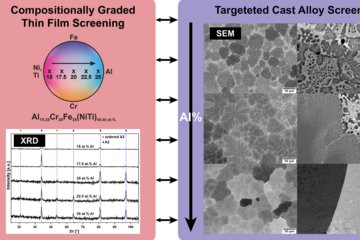All genres
261.
Talk
Zinc alloy coatings and nano-composite coatings for corrosion protection: From the basics to new challenges. IIM NMD ATM 2019: Advanced Materials for Industrial and Societal Applications, Kovalam, Thiruvananthapuram, India (2019)
262.
Talk
Intelligent coatings for corrosion protection: on the need for new coating concepts. International Conference on Corrosion Protection and Application (ICCPA 2019), Chongqing, China (2019)
263.
Talk
Scanning Kelvin Probe based techniques for mapping hydrogen distribution in metals and their application for investigating hydrogen embrittlement. Workshop “Hydrogen in Metals”, St Anne’s College, Oxford, UK (2019)
264.
Talk
Hydrogen embrittlement, hydrogen traps, high sensitive detection of hydrogen with high spatial resolution, corrosion. Dreiländerkorrosionstagung, Dechema-Haus, Frankfurt, Germany (2019)
265.
Talk
Hydrogen embrittlement of medium Mn steels with ferrite matrix or austenite matrix. 4th High Manganese Steel 2019 HMnS, Aachen, Germany (2019)
266.
Talk
The Influence of Microstructure on Zn–Al–Mg Alloy Reactivity: A SKP-based Approach. Scientific Advisory Board Meeting 2019, 6-years Evaluation of the Max-Planck-Institut für Eisenforschung GmbH – Scientific Highlights Session, Düsseldorf, Germany (2019)
267.
Talk
Die Kelvinsondentechnik in der Korrosion: von der Grundlagenforschung bis hin zu potentiellen Anwendungen im Feld. ProcessNet Meeting “Elektrochemische Prozesse”, Dechema-Haus, Frankfurt, Germany (2019)
268.
Talk
The influence of microstructure on Zn–Al–Mg alloy reactivity investigated by SKP and SKPFM in changing atmospheres. Eurocorr 2018, Krakow, Poland (2018)
269.
Talk
Heapocrates – Recent advances. DFG SPP 1568 Workshop – Design and generic Principles of Self-Healing Materials, Jena, Germany (2018)
270.
Talk
Novel zinc-nanocontainer composite coatings for intelligent corrosion protection. 11th Intrenational Conference on Zinc And Zinc Alloy Coated Steel Sheet- GALVATECH 2017, The University of Tokyo, Tokyo, Japan (2017)
271.
Talk
Corrosion protection by composite coatings containing conducting polymer particles: elucidation of the “protection zone”. 232nd ECS Fall Meeting 2017, National Harbour, USA (2017)
272.
Talk
Organic coatings for corrosion protection: self-healing at the delaminated interface. 232th Meeting of the Electrochemical Society, National Harbor, USA (2017)
273.
Talk
Capsular networking and accelerated trigger signal spreading velocity in smart redox responsive coatings for corrosion protection. 232nd ECS Fall Meeting 2017, National Harbor, MD (greater Washington, DC area), USA (2017)
274.
Talk
A Novel Potentiometric Approach to a Quantitative Characterization of Oxygen Reduction Kinetics at Buried Interfaces and under Ultrathin Electrolyte Layers. ECASIA 2017, Montpellier, France (2017)
275.
Talk
Capsular networking and accelerated trigger signal spreading in smart anti corrosion coatings. Joint Eurocorr 2017 & 20th ICC congress, Prague, Czech Republic (2017)
276.
Talk
A Novel Potentiometric Approach to a Quantitative Characterization of Oxygen Reduction Kinetics at Buried Interfaces and under Ultrathin Electrolyte Layers. Second International Conference on Electrochemical Science and Technology – ICONEST 2017, Indian Institute of Science, Bangalore, India (2017)
277.
Talk
The impact of trigger signal spreading velocity on self-healing performance in smart anti-corrosion coatings. 6th International Conference on Self-Healing Materials (ICSHM) 2017, Friedrichshafen, Germany (2017)
278.
Talk
Novel Approaches for Characterizing the Delamination resistance of Organic Coatings. 10th International Workshop on Application of Electrochemical Techniques to Organic Coatings –AETOC, Billerbeck, Germany (2017)
279.
Talk
Degradation Mechanism of Molds for Precision Glass Molding. Microscopy & Microanalysis 2017 Conference, St. Louis, MO, USA (2017)
280.
Talk
Using a Novel In-situ/Operando Chemical Cell to Investigate Surface Reactions such as the Reduction of Oxygen and Surface Oxides. AVS 63rd International Symposium & Exhibition, Nashville, TN, USA (2016)











